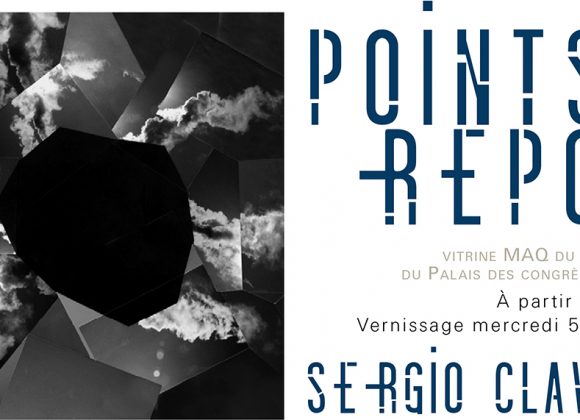Inspiré par le grand poète britannique T.S. Eliot et certaines expérimentations en dessin, l’architecte et artiste Sergio Clavijo ajoute à la technique du photocollage une dimension à la fois urbaine et métaphorique. « Points-repos est un projet photographique dans lequel les cheminées d’évacuation d’air chaud, qui deviennent visibles dans le paysage montréalais lorsqu’il fait très froid, symbolisent la vie intérieure de la ville. Chaque image est composée d’un
collage de cheminées isolées, formant une masse ou un « point » qui rappelle un corps qui respire ou qui brûle », explique l’artiste. « L’oeuvre renvoie à une gravure d’Athanase Kircher intitulée Pyrophylaciorum parue dans Mundus Subterraneus, ouvrage que cet érudit jésuite publie en 1664. Dans ses travaux, Kircher cherche à expliquer les phénomènes naturels en les observant d’une manière scientifique, attentive et détaillée. Mais ses explications relèvent bien plus de l’imaginaire que de l’expérience, ce qui leur prête quelque chose de merveilleux. En 1971, Robert Smithson, le célèbre artiste du Land Art, réalise un croquis d’après cette même gravure : il l’intitule After Kircher. Une des caractéristiques de l’oeuvre de Smithson c’est de se servir des données empiriques d’un paysage naturel pour le décrire au moyen d’une métaphore. Ainsi, ses oeuvres transforment le paysage réel en un paysage de fiction. À leur tour, les collages que je vous présente reconstituent le paysage urbain tout en lui faisant subir une transformation poétique « au point-repos du monde qui tourne ». Cette transformation vise à donner une dimension imaginaire et fictionnelle à notre expérience de la ville, dimension essentielle à l’élargissement de notre vision de l’espace urbain. »
Poème
Au point-repos du monde qui tourne. Ni chair ni privation de chair;
Ni venant de, ni allant vers; au point-repos, là est la danse;
Mais ni arrêt ni mouvement. Ne l’appelez pas fixité,
Passé et futur s’y marient. Non pas mouvement de ou vers,
Non pas ascension ni déclin. N’était le point, le point-repos,
Il n’y aurait nullement danse, alors qu’il n’y a rien que danse.
Je ne puis que dire : nous avons été là, mais où, je ne saurais le dire.
Et je ne saurais dire pour combien de temps : ce serait situer la chose dans la durée.
La liberté intérieure à l’égard du désir pratique,
La délivrance de l’agir et du souffrir, la délivrance de la contrainte
Intérieure et extérieure, encore qu’environnées
D’une grâce du sentir, d’une lumière blanche en repos et mouvante,
Erhebung sans mouvement, concentration
Sans élimination, à la fois nouveau monde
Et l’ancien rendu explicite, appréhendé
Dans l’accomplissement de sa partielle extase,
La résolution de sa partielle horreur.
Pourtant l’enchaînement du passé et de l’avenir
Tissés dans la faiblesse du corps changeant
Protège l’homme du ciel et de la damnation
Que la chair ne peut supporter.
« Burnt Norton », in Quatre Quatuors, traduction Pierre Leyris
English Version
Inspired by the great English poet T.S. Eliot and some experimental drawings, the artist and architect Sergio Clavijo adds to the technique of
photocollage a dimension that is both urban and metaphorical. “Still Points is a photography project that uses the chimney stacks that appear in the Montreal cityscape during its coldest days as a symbol of its inner urban life. Each of these images is a collage of isolated chimneys that form a mass or ‘point’, depicting a body that seems to be breathing or burning”, the artist explains. “The work refers directly to Athanasius Kircher’s engraving ‘Pyrophylaciorum’ that appears in his book Mundus Subterraneus published in 1664. Kircher, a Jesuit polymath, sought to explain natural phenomena by observing them in a scientific, attentive and detailed fashion but his explanations reveal more about imagination than experience; the result is a unique hint of wonder. ‘’Robert Smithson, the artist renowned for his land art, refers to Kircher’s engraving in his 1971 sketch ‘After Kircher’. Smithson’s work typically gathers empirical data from a natural landscape and transforms it into a metaphorical landscape as a means of describing the existing. In this way his work makes the ‘real’ landscape, a fictional one. ‘’These collages are but a reconstitution of the city’s landscape, yet they are poetically transformed ‘at
the still point of the turning world’. I propose to mix our experience of the city with fictional and imaginative qualities. These qualities are at the core of broadening our vision of the urban realm.”
Poem
At the still point of the turning world. Neither flesh nor fleshless;
Neither from nor towards; at the still point, there the dance is,
But neither arrest nor movement. And do not call it fixity,
Where past and future are gathered. Neither movement from nor towards,
Neither ascent nor decline. Except for the point, the still point,
There would be no dance, and there is only the dance.
I can only say, there we have been: but I cannot say where.
And I cannot say, how long, for that is to place it in time.
The inner freedom from the practical desire,
The release from action and suffering, release from the inner
And the outer compulsion, yet surrounded
By a grace of sense, a white light still and moving,
Erhebung without motion, concentration
Without elimination, both a new world
And the old made explicit, understood
In the completion of its partial ecstasy,
The resolution of its partial horror.
Yet the enchainment of past and future
Woven in the weakness of the changing body,
Protects mankind from heaven and damnation
Which flesh cannot endure.
Burnt Norton’ by T.S. Eliot in Four Quartets
Crédits : @sergioclavijo


